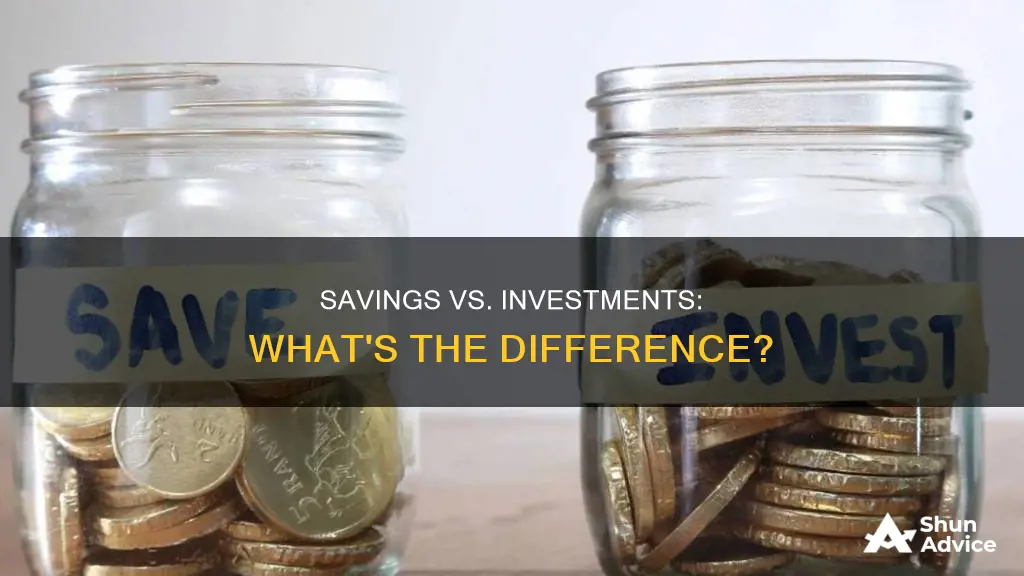
The concept of savings being equal to investment is a fundamental principle in economics, specifically in national income accounting. This concept, also known as the saving-investment identity, states that the amount saved in an economy will be reflected in investments in new physical machinery, inventories, and similar areas.
In a closed economy without a government, gross domestic product (GDP) is equivalent to gross domestic income (GDI), and income (Y) can be expressed as the sum of consumption (C) and savings (S). From a spending perspective, income (Y) can also be viewed as the aggregate of consumption (C) and investment (I). Therefore, the equation Y = C + S implies that savings and investment are equal, i.e., S = I.
However, it is essential to recognise that this equation holds true due to the specific definitions of savings and investment in economics. Savings encompass the funds that are not spent on consumption, including money in bank accounts, retirement funds, and profits retained by businesses. On the other hand, investment includes not only the acquisition of new capital goods but also 'stockbuilding' or 'inventory accumulation', which are goods that firms intended to sell but were unable to.
While the saving-investment identity is a useful concept, it does not imply a direct causal link between an increase in savings and a rise in investment. Businesses may respond to higher inventories by reducing output and intended investment, which, in turn, lowers income and forces an unintended reduction in savings. Thus, while the saving-investment identity holds at any given point in time, it does not necessarily lead to a higher level of investment when savings increase.
| Characteristics | Values |
|---|---|
| Definition of private savings | The money households and businesses set aside, rather than spending it all on consumption. |
| Importance of private savings | They act as the domestic supply of loanable funds within a country. |
| Components of private savings | Private savings come from two main sources: households and businesses. |
| Calculating private savings | Private savings = household savings + business sector savings |
| Private savings and national savings | Private savings are another component of national savings. National savings are equivalent to private savings plus public savings (government savings). |
| Factors affecting private savings levels | Income, wealth, debt, interest rates, inflation, public savings (government policy), external factors (terms of trade and foreign saving), and demographic factors. |
What You'll Learn
- The paradox of thrift: Saving more does not always lead to more investment
- Investment includes 'stockbuilding' or 'inventory accumulation'
- Saving is defined as income not spent on consumer goods
- In neo-classical economics, the level of saving will equal the level of investment
- Saving is influenced by interest rates and confidence

The paradox of thrift: Saving more does not always lead to more investment
The paradox of thrift, or the paradox of saving, is an economic theory that asserts that an increase in individual saving can lead to a decrease in aggregate demand and, consequently, a decline in gross output and total savings. This phenomenon contradicts the intuition that what benefits an individual within an economy will benefit the entire population. The paradox of thrift highlights a disconnect between individual and group rationality, underscoring the complexities of economic behaviour.
The theory, popularised by British economist John Maynard Keynes, is rooted in the observation that total income equals total output in an equilibrium state. According to Keynes, if income has a direct influence on saving, an increase in autonomous saving will shift the equilibrium point downward, resulting in a decline in saving that may outweigh the initial increase. This occurs because higher savings lead to reduced consumer spending, causing lower revenues for businesses. This decreased demand triggers a contraction in output, leading to lower incomes for employers and employees alike. Ultimately, the population's total savings may remain unchanged or even decrease due to lower incomes and a weakened economy.
The paradox of thrift is particularly pertinent during economic recessions. Keynesian theory suggests that the appropriate response to an economic downturn is to increase spending and risk-taking while reducing savings. This approach may seem counterintuitive, as individuals and households typically opt to cut back on expenses during challenging times. However, in a recessed economy, some factors of production, such as land, labour, and capital, remain underutilised. By encouraging more spending, Keynesians aim to stimulate economic growth and make better use of these resources.
Criticisms of the paradox of thrift come from neoclassical economists, who argue that savings represent loanable funds, particularly when held in banks. In this view, increased savings lead to higher potential lending, driving down interest rates and stimulating borrowing, investment, and spending. Additionally, neoclassical economists assert that if demand slackens, prices will adjust downward (barring government intervention), and these lower prices will stimulate demand, albeit at lower profit margins.
The paradox of thrift underscores the intricate dynamics between saving, investment, and economic growth. While saving is generally considered prudent for individuals, collectively increasing savings may have unintended consequences for the economy as a whole. This paradox highlights the need to carefully consider the interplay between microeconomic and macroeconomic behaviours and the potential for seemingly rational individual actions to have adverse aggregate outcomes.
Planning Savings and Investments: Strategies for Financial Freedom
You may want to see also

Investment includes 'stockbuilding' or 'inventory accumulation'
Investment includes stockbuilding or inventory accumulation, which is a component of gross domestic product (GDP). Inventory investment refers to the difference between the goods produced (production) and those sold (sales) in a given year. This can be calculated as:
> Inventory investment = production – sales
Inventory investment can be positive or negative. It is positive when production exceeds sales, leading to a higher stock of inventory at the end of that period. Conversely, it is negative when sales are greater than production, resulting in a lower inventory stock.
Inventory investment can be further categorised into intended and unintended types. Intended inventory investment occurs when a firm deliberately adjusts its inventory levels, either by producing more or less than expected sales, to manage costs or ensure sufficient stock. Unintended inventory investment, on the other hand, arises from mispredictions of customer demand, resulting in unexpected increases or decreases in inventory.
In macroeconomics, inventory investment plays a crucial role in achieving equilibrium in the goods market. Equilibrium is achieved when the supply of goods (output) equals the demand for goods, including various types of expenditure such as consumer expenditure, government expenditure, and investment expenditure. If there is a mismatch between supply and demand, it leads to disequilibrium, reflected in positive or negative unintended inventory investment.
While investment in inventories is generally a small proportion of total spending, it can have a noticeable impact on aggregate GDP growth due to its volatile nature. A positive contribution to GDP growth occurs when there is stockbuilding, while negative stockbuilding reduces GDP growth.
Firms have various motives for holding inventories, including:
- Ensuring adequate materials for production needs, thereby mitigating supply disruptions, price volatility, and shortages.
- Avoiding changes in production levels by maintaining stocks of finished goods. This is relevant when adjusting production rates is costly, such as paying overtime to increase output.
- Maintaining target stock levels to meet customer demand and avoid losing customers due to stockouts.
In summary, investment in stockbuilding or inventory accumulation is an essential aspect of a country's economy, influencing GDP calculations and reflecting firms' strategies to manage costs, ensure production efficiency, and meet customer demands.
Savings and Investment: Interplay in a Closed Economy
You may want to see also

Saving is defined as income not spent on consumer goods
Economists define savings as the funds used for investment, which is derived from the concept that in a closed economy with no government, gross domestic product (GDP) equals gross domestic income (GDI). This equation, GDI = C + S = C + I = GDP, implies that savings and investment are equal. However, critics argue that this definition may not capture the intuitive understanding of savings and investment.
In the context of private savings, households and businesses set aside money instead of spending it on consumption. This includes money saved in bank accounts, retirement funds, and profits retained by businesses. Private savings act as a domestic supply of loanable funds, which can be invested in businesses, infrastructure projects, and other productive activities. High levels of private savings can contribute to economic growth by boosting capital accumulation and lowering borrowing costs.
The formula for private savings (S) is:
> S = Y - T - C
Where Y is aggregate income, T is tax revenue, and C is consumption spending.
Private savings are a crucial component of a nation's overall savings, which also includes public savings (government savings). National savings represent the total amount of money saved within a country and are essential for driving long-term economic prosperity.
Retirement Planning: 401(k)s, Investing, or Saving?
You may want to see also

In neo-classical economics, the level of saving will equal the level of investment
Neoclassical economics is a broad theory that focuses on supply and demand as the driving forces behind the production, pricing, and consumption of goods and services. It emerged in the 1900s as a competitor to the earlier theories of classical economics. Neoclassical economics holds that a consumer's first concern is to maximise personal satisfaction, also known as utility. Therefore, they make purchasing decisions based on their evaluations of the utility of a product or service.
In neoclassical economics, the level of saving will equal the level of investment. This is because savings are defined as the funds used for investment. This is derived from the identity that in a closed economy with no government, gross domestic product (GDP) equals gross domestic income (GDI). This can be expressed as:
> GDI = C + S = C + I = GDP
Where C is consumption, S is savings, I is investment, and GDP is gross domestic product.
This equation shows that savings and investment are two sides of the same coin. Savings is income not spent on consumption, and investment is spending on capital goods. In other words, savings are the funds that are available for investment.
This idea is further supported by the saving-investment identity, which states that the amount saved in an economy will be the amount invested in new physical machinery, inventories, and similar areas. In an open economy, this can be expressed as:
> Private saving + Governmental saving + Foreign investment domestically = Private physical investment
Here, governmental saving refers to the government budget surplus or the negative of the deficit. Foreign investment domestically refers to capital inflows from abroad.
While an increase in savings does not necessarily lead to a direct increase in investment, the saving-investment identity holds true at any given point in time. This is because investment is defined to include inventory accumulation, both deliberate and unintended. Therefore, if consumers decide to save more and spend less, the resulting fall in demand would lead to an increase in business inventories, bringing saving and investment into balance.
Neoclassical economics also states that savings determine investment. This is based on the assumption that consumers make rational decisions to maximise utility, and that businesses aim to maximise profits. In this framework, competition leads to an efficient allocation of resources within an economy, and the forces of supply and demand create market equilibrium.
In summary, neoclassical economics posits that the level of saving will equal the level of investment. This is based on the definitions of savings and investment, as well as the underlying assumptions about consumer behaviour and market dynamics.
Solow Model: Investment Savings Strategy for Long-Term Growth
You may want to see also

Saving is influenced by interest rates and confidence
Interest rates play a significant role in influencing saving behaviours. When interest rates are higher, individuals are incentivised to save as they can expect a higher rate of return on their savings. This is especially true when interest rates are higher than the inflation rate, as this means that savers will increase their real wealth. Conversely, when interest rates are low, the rewards for saving are reduced, and individuals may be less inclined to save.
However, the relationship between interest rates and saving is not always straightforward. For example, during the 2008-2013 recession, interest rates were cut, but the saving ratio increased because consumers were pessimistic about the future. In this case, the impact of the recession on people's economic outlook was a more influential factor than the interest rate.
Confidence in the future economic climate is a key factor in saving behaviours. When individuals are optimistic about the future, they are more likely to spend and borrow, whereas when they are pessimistic, they tend to save more and focus on paying off debts. For example, during periods of rising unemployment and falling house prices, individuals tend to save more.
Additionally, income levels influence an individual's ability to save. People with higher incomes tend to have more disposable income available for savings, whereas those with lower incomes may struggle to save after meeting their essential expenses.
A Safe Investment: Post Office Savings Schemes
You may want to see also
Frequently asked questions
Saving involves income that is not consumed. Typically, surplus income is saved in a bank account, but it could also be saved as cash. Investment, on the other hand, is defined as an addition to the capital stock, such as spending on factories or new capital, or on human capital like training and education.
In a closed economy, savings and investment are equal. This is because investment is determined by the available savings in the economy. However, this does not mean that an increase in savings must lead directly to an increase in investment. Businesses may respond to increased inventories by decreasing output and intended investment.
The paradox of thrift states that a desire by consumers to increase savings ends up reducing output, and savings do not increase. Even if the end result is a lower level of investment, the saving-investment identity holds true at any given point in time.







